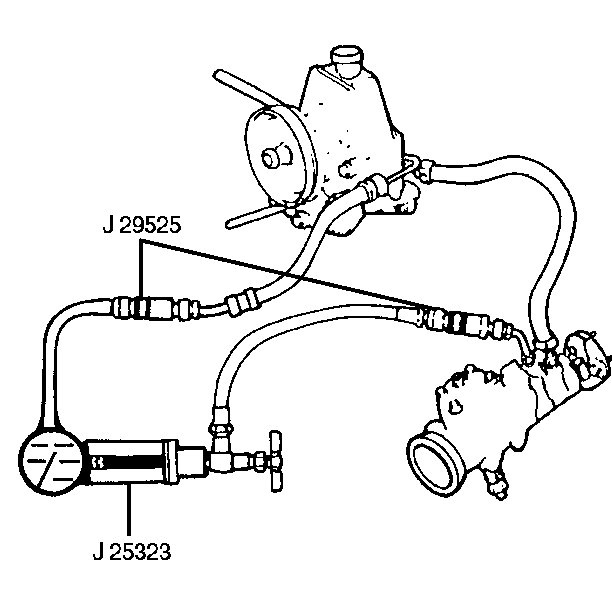Tools Required
- Front Inside Handle Bezel Screw Power Steering System
Analyzer
- Front Handle Bezel and Lock Pad Power Steering System
Analyzer 18 mm Adapter
- Inspect the following components.
| • | The reservoir for proper fluid level. |
| • | The pump belt for proper tension. |
| • | The tires for correct air pressure. |
| • | The power steering system and replace the components as necessary. |
Important: All tests are made with the engine idling at normal operating temperature.
Check the idle speed adjustment and, if necessary, adjust to the correct specification.

- Place a container under the steering gear or
the steering pump in order to catch the fluid that falls when you disconnect
or connect the hoses.
- With the engine off: disconnect the pressure hose at the steering
gear or the power steering pump. Thread the female adapter into the pressure
hose and the male adapter into the gear or pump. Use Front Handle Bezel and Lock Pad
.
Connect Front Inside Handle Bezel Screw
to the adapters.
- If Front Inside Handle Bezel Screw
has never been
used it will be necessary to bleed the power steering system to remove all
the air. Refer to Bleeding the Power Steering System. The analyzer gate must
be open during this procedure.
- Add power steering fluid to the pump or reservoir if required.
- Run the engine at idle speed with the gate valve open and record
the flow (A) and the pressure (B).
| 8.1. | If the flow is below 7.44 L/min (2 gpm) the pump
may need repair, but still continue with the test. |
| 8.2. | IF the pressure is above 1035 kPa (150 psi) check
the hoses for restriction and check the steering gear. |
- Partially close the gate valve to build 4278 kPa (620 psi).
Record the flow (C).
| 9.1. | If the flow (C) drops more than 3.7 L/min. (1 gpm)
under the original flow (A), disassemble the pump and replace the ring, rotor,
and vanes. |
| 9.2. | If the pressure plates are worn or cracked, replace them. Replace
all O-ring seals when you reassemble the pump. |
Notice: Do not leave the valve fully closed for more than five seconds. This
causes internal damage to the power steering pump.
- Completely close and partially open the
gate valve three times. Record the "gate closed" pressure (D).
- Check the pressures specifications at the end of this section.
If the pump pressure recorded is 690 kPa (100 psi) lower than
the minimum specification listed, replace the flow control valve in the pump.
If the pressure recorded is above the maximum specification listed, the flow
control valve in the pump should be removed and cleaned or replaced. If the
system is really dirty, both the steering gear and the pump must be completely
disassembled and cleaned before further use. In addition, the fluid reservoir
must be flushed completely before any further use.
- Increase the engine speed from idle to about 1500 RPM.
Record the flow (E).
- If this flow (E) varies more than 3.7 L/min (1 gpm)
from the original flow you measured (A), the flow control valve should be
removed and cleaned or replaced.
Notice: Do not hold the steering wheel against the stop. This may damage the
pump.
- Turn the steering wheel
lightly against both stops. Record the pressure and the flow (F).
- Pressures developed at both stops should be nearly the same as
the maximum pump output (D). At the same time, the flow should drop below
1.85 L/min. (0.5 gpm).
- If the pressure does not reach maximum output or the flow does
not drop below the specified values, excessive internal leakage is occurring.
Remove and disassemble the steering gear and remove the control valve. Repair
the steering gear.
- Turn the steering wheel in both directions and release quickly
while watching the pressure gauge. The needle should move from the normal
pressure reading and snap back as the wheel is released. If it comes back
slowly or sticks, the rotary valve in the steering gear is sticking. Remove,
disassemble, and clean the rotary valve. If the system contains a lot of dirt
and foreign material, disassemble the pump and gear and clean both In addition,
the fluid reservoir must be flushed completely before any further use.
- If the problem still exists, the steering and front suspension
must be thoroughly examined.

